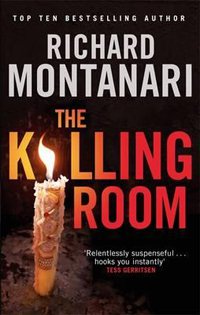 Written by Richard Montanari — Winter grips Philadelphia. Ice floes clunk in the Delaware and Schuylkill rivers, but Detectives Kevin Byrne and Jessica Balzano of the Homicide Unit have, for once, a clean plate. Three recent cases – three suspects in custody. All seems good, but when Balzano picks up the phone and receives a bizarre message, things start to go rapidly downhill.
Written by Richard Montanari — Winter grips Philadelphia. Ice floes clunk in the Delaware and Schuylkill rivers, but Detectives Kevin Byrne and Jessica Balzano of the Homicide Unit have, for once, a clean plate. Three recent cases – three suspects in custody. All seems good, but when Balzano picks up the phone and receives a bizarre message, things start to go rapidly downhill.
“One God. Seven churches. You will find the first of the dead at Amber and Cumberland,” says the message. Expecting a hoax, Balzano and Byrne go and check. Near the address they see a patrol car, lights flashing, and one look at the face of the officer tells them that something terrible has happened. In a derelict chapel, they find a young man. Naked, and near death, he’s been bound up with barbed wire.
Despite the efforts of the emergency team, the man dies, and enquiries reveal that he is a former cop. There are more horrifically inventive murders, and all have been carried out in the basements of disused churches. As a devious network TV reporter tries to get inside the story, Byrne is temporarily sidetracked. After befriending an orphaned teenager to steer him away from street crime, he is enraged to find the boy being warned off by a local dealer. Byrne visits the dealer, and after the red mist has descended and cleared, he finds that the reporter has phone footage of the encounter.
On top of all this, The Killing Room has a backstory which initially seems unconnected to the city murders. In the backwoods of West Virginia, a girl grows up in poverty. After watching her sister being abused by their alcoholic father, she visits a traveling band of evangelists. Mesmerised by its leader, The Preacher, she joins them. The Holy Thunder Caravan moves on through Kentucky, Ohio and Pennsylvania. The girl experiences another side of the holy spirit, and is cast adrift. This story sits in the narrative like a puzzle, but the link takes shape as the main story develops, and the final tie-in is clever and unexpected.
Byrne gets closer to understanding the murder pattern. His knowledge of the potency of religious symbolism, and a visit to his old parish priest, combine to turn the candle flickering in the gloom into something more illuminating. Montanari’s style of writing means that we turn the pages anxiously, even if we are not always certain what is going on. Existing fans of the Byrne and Balzano series will feel at home, if not at ease, beneath the towers and spires of The City of Brotherly Love, while new readers will admire the rich and brutal descriptive passages.
This is another novel which has a supernatural thread woven into its cloth. We are not talking of ghosts or things that go bump in the night, but about a policeman who has premonitions and dreams beyond the normal hunches of a fictional cop. The Catholic Church in the abstract looms over the narrative, and the physical presence of the derelict churches is immense. Within the smell of general decay there is a tang of incense from masses celebrated long ago, alongside the sounds of pigeons fluttering in the rafters, you can hear the dry rustle of the vestments of dead priests.
There are pages of rather portentous Bible-speak, and dramatic quotes from Revelations. For some, this gothic atmosphere may be too much, and you may question whether Balzano and the rest of Byrne’s more grounded colleagues would have got to the root of this mystery without his intuition pointing the way. Finally the loose ends are tied up in a neat, if slightly improbable, knot.
Sphere
Print/Kindle/iBook
£3.99
CFL Rating: 4 Stars







